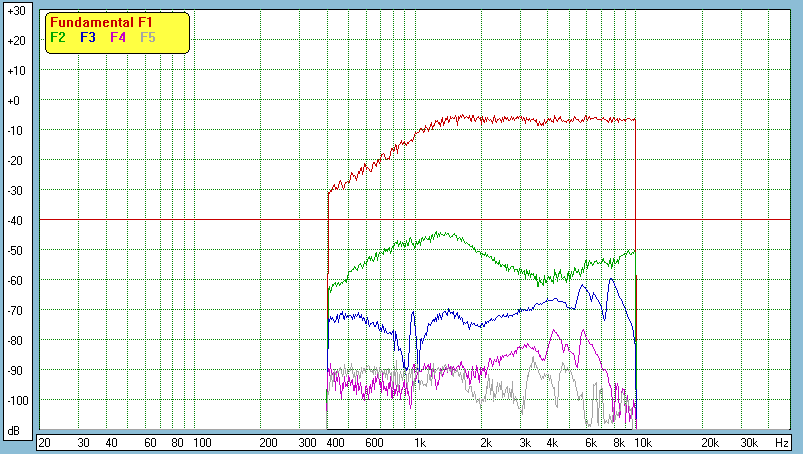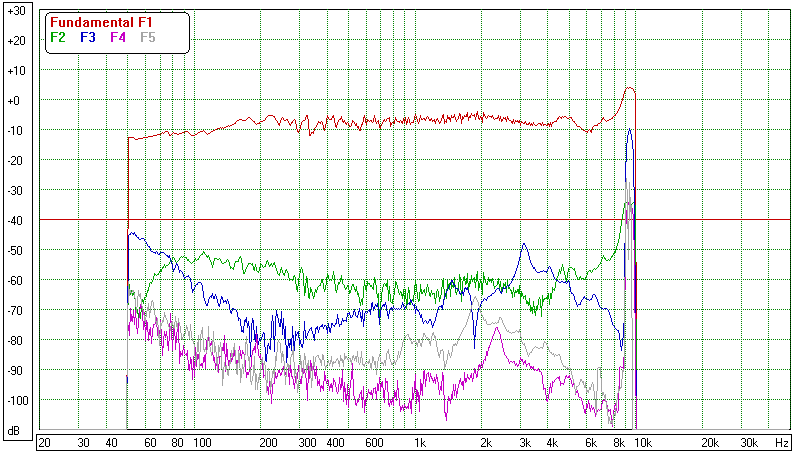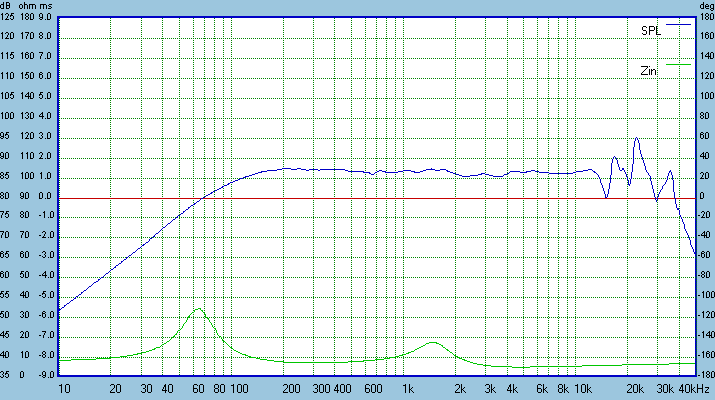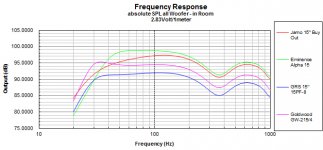Your answer to my Peter Comeau Hi-Fi World link above just is not about what PC writes in the article. Better to accept that there are other wievs perhaps better founded.
Erling,
That article by Peter Comeau is really not very accurate from a technical standpoint. I do not believe he understands the resonant frequencies of a bass reflex enclosure, there is no system resonance at the box tuning frequency where the port is producing the majority of the sound, and his extrapolation to OB theory in my opinion misses the mark. It is well documented, sounds good to the non engineer, has some nice plots and pictures, but is technically incorrect.
Martin
Actually you might be surprised. John Busch built a pair of baffles with the GRS 15 and the little Vifa a few weeks back. Same crossover as the Peerless + Vifa Manzanita. He loves it and we've discussed it in great detail over the past weeks. Of course the trade off is that it is on a much bigger baffle. John will be publishing the design over on the other thread soon. He's been running them off a single ended KT88 amp with great results.Pano, the Vifas are not very sensitive and the GRses probably nothing compared to the Manzanita Peerlesses.
I'm keen to try a version with 2 woofers per side, as per the photo I posted earlier. I've asked John to test this version when he gets a chance.
I am sorry Martin but you are not at all discussing my link, your arguments you have to take with Mr Comeau himself so that you perhaps can agree or disagree. Mine was only about comparing the Alpha15 and the Beta15 in a moderate size room. I would tend to think that most of our listeningrooms are moderate in size, SL probably an exception. But I don't think that roomsize other than if you listen over a longer distance would have anything to do with what you actually hear. Neither I think that bassquality is influenced that much by speaker placement, bass quantity certainly is and might easily be mixed up with other qualities.
It is however to me more telling that neither of my experienced Swedish Hi-Fi Forum friends really liked the Alpha15s which I put forward to them at various occasions. They were polite but never really enthusiastic, like what the reactions to my 'Volks-OB' was. I never quite understood until I played the first tone with the IB15s. I am going to dig up the 'Volks-OB* basses from the basement they are 0.7 Qts units as estimated by the seller.
It's a pity that so much prestige is invested in these arguments now and also perhaps different people hear different but at least to me the Alpha15 days are over how enthralling sims ever look.
/Erling
It is however to me more telling that neither of my experienced Swedish Hi-Fi Forum friends really liked the Alpha15s which I put forward to them at various occasions. They were polite but never really enthusiastic, like what the reactions to my 'Volks-OB' was. I never quite understood until I played the first tone with the IB15s. I am going to dig up the 'Volks-OB* basses from the basement they are 0.7 Qts units as estimated by the seller.
It's a pity that so much prestige is invested in these arguments now and also perhaps different people hear different but at least to me the Alpha15 days are over how enthralling sims ever look.
/Erling
Last edited:
I am sorry Erling, I thought I was following your link.
I think it is time for me to drop out and do something else more productive. I think we have beaten this topic to death.
Martin
I think it is time for me to drop out and do something else more productive. I think we have beaten this topic to death.
Martin
sreten,
Your answer to my Peter Comeau Hi-Fi World link above just
is not about what PC writes in the article. Better to accept
that there are other wievs perhaps better founded.
/Erling
Hi,
True, it also about what he hasn't written. Your somewhat patronising
comment is very applicable in this case, I don't misrepresent opinion as
fact, there are views founded on better information than that article.
rgds, sreten.
+1. Time to go saw wood and solder wires. 😀
+2. Paper exercise have serious limitations...
We can argue all day over which woofer is better on an OB just as we can any other woofer in another project. But we can agree that there are a handful of useable 15” woofers that can successfully be used on OB. The Alpha is often mentioned because it’s been used in many projects and heavily scrutinized for its magnet size, sound, build quality, etc. Having purchased the Jamo buyout woofers from PE for $20 I can readily say price does not coincide with quality. Despite the poorer looking performance (of my basic sim) the sound quality to my ears is superb in my son’s bedroom (maybe 14’ x 16’). Subjectively, I might even say the cheaper Jamo’s sound more musical than the Alphas. But they both certainly work great and produce full, rich bass. I would like to hear the Beta 15 (even with its lower Qts spec) and bet based on listener feedback they sound very good (tho they require boost of some kind which complicates the simplicity of this design). But I have no doubt many will prefer its sound once setup and dialed in properly. One can argue that any higher quality, lower Qts, greater Xmas 15” driver once properly ‘dialed in’ and optimized to work on an OB might outperform the more modest Alpha, GRS, Goldwood (and those superb sounding Jamo buyouts I wish I bought more of for $20).
To my ears, once above 200Hz, the Alphas suck in H-frames and probably on a simple OB baffle too. Whenever people criticize them I feel they’ve heard them working above 200Hz and understand their frustration as to why so many enjoy them. To my ears, the Alphas in H-frames are a standard of sorts (not necessarily the best or the worst, rather a benchmark others can be judged against). They trump any and all of the powered subs I’ve heard and built (my 12” powered sub uses the venerable and highly regarded ACI 12 woofer from several years ago). The Alpha’s provide great bass in my house. If there are better drivers for more or less money I’d love to hear them but for the price I really think they provide a lot of performance in the right design. It may not be the best but it’s certainly good enough and satisfying to me. I doubt I will look to spend more.
Here’s another quick sim of these drivers on a different sized baffle comparing their performance that I think illustrates how they may perform differently. As expected, lower efficiency trades for more extension. The higher Qts drivers roll of less rapidly than the lower (the Jamo has a Qts of .85). I’d try the GRS and Goldwood for a home project based on what I see on the charts and would expect them to perform good enough while providing satisfying bass.
To my ears, once above 200Hz, the Alphas suck in H-frames and probably on a simple OB baffle too. Whenever people criticize them I feel they’ve heard them working above 200Hz and understand their frustration as to why so many enjoy them. To my ears, the Alphas in H-frames are a standard of sorts (not necessarily the best or the worst, rather a benchmark others can be judged against). They trump any and all of the powered subs I’ve heard and built (my 12” powered sub uses the venerable and highly regarded ACI 12 woofer from several years ago). The Alpha’s provide great bass in my house. If there are better drivers for more or less money I’d love to hear them but for the price I really think they provide a lot of performance in the right design. It may not be the best but it’s certainly good enough and satisfying to me. I doubt I will look to spend more.
Here’s another quick sim of these drivers on a different sized baffle comparing their performance that I think illustrates how they may perform differently. As expected, lower efficiency trades for more extension. The higher Qts drivers roll of less rapidly than the lower (the Jamo has a Qts of .85). I’d try the GRS and Goldwood for a home project based on what I see on the charts and would expect them to perform good enough while providing satisfying bass.
Attachments
Pano,
Not really, I am not very surprised, most people, like myself are very homeblind to what you seem to hear straightly. That's why second opinions with really skilled people are so invaluable.
/Erling
Not really, I am not very surprised, most people, like myself are very homeblind to what you seem to hear straightly. That's why second opinions with really skilled people are so invaluable.
/Erling
Godzilla,
really a very good post. I am not at all blaming anyone , the least MJK, for fooling people. However not recognizing second opinons are bad. But Martin really compared AE Dipole15 to his Alpha15 and said they were better but not so much better than the Alphas to merit buying.
That is of course a very unclear statement, how much better, in what respect better, lower going, cleaner going and so on. The fact is you are not at all much more informed by those kind of statements. Just left over to some kind of subjective judgement, which you not perhaps realize.
I have argued that some people do hear differencies between the Alpha15 and the Beta15, like in my link above and like the earlier post by Adolf Corkscrew and like arguments put forward by Mr Nelson Pass previously.
Myself I only argued that the Alpha15s are markedly inferior to AE IB15s in an active setup I use, not the least soundwise.
This last point is of course open for everyone to counterproof. 🙂
/Erling
really a very good post. I am not at all blaming anyone , the least MJK, for fooling people. However not recognizing second opinons are bad. But Martin really compared AE Dipole15 to his Alpha15 and said they were better but not so much better than the Alphas to merit buying.
That is of course a very unclear statement, how much better, in what respect better, lower going, cleaner going and so on. The fact is you are not at all much more informed by those kind of statements. Just left over to some kind of subjective judgement, which you not perhaps realize.
I have argued that some people do hear differencies between the Alpha15 and the Beta15, like in my link above and like the earlier post by Adolf Corkscrew and like arguments put forward by Mr Nelson Pass previously.
Myself I only argued that the Alpha15s are markedly inferior to AE IB15s in an active setup I use, not the least soundwise.
This last point is of course open for everyone to counterproof. 🙂
/Erling
Last edited:
Now steering back to were we halted. I do think the Zaph combo would merit OB use. If someone really would venture I would welcome someone taking on Dayton Audio PS220-8 for a serious challange. German Hobby HiFi measured this unit in its last number and there are absolutly extremly good promises with it, but difficulties ahead.
Good Luck ! 🙂
/Erling
Good Luck ! 🙂
/Erling
Last edited:
Hi.
Completely different ballgame to the scope of this thread. I guess you'd want
to set the baffle hump centred on 400Hz, add a 3.5Khz trap filter and then
use a couple of 96dB or so bass units. Off topic in this thread though IMO.
rgds, sreten.
An externally hosted image should be here but it was not working when we last tested it.
Completely different ballgame to the scope of this thread. I guess you'd want
to set the baffle hump centred on 400Hz, add a 3.5Khz trap filter and then
use a couple of 96dB or so bass units. Off topic in this thread though IMO.
rgds, sreten.
Yes sreten measurements not so far from the manufacturer's. But distortion down below 0.1 % from 300 Hz upwards at 90 dB with and very good extension of response up to 20 kHz. In Audocircle Richard already put it forward as a substitute for Visaton B200. In fact I think it is with some frequency adjustments passive or perhaps rather active.
/Erling
/Erling
I'd like to comment a bit to Pano once more even if it is farfield now:
Your last version of the Manzanita and its crossover I never understood. It seemed to far diverging between bass and treble to really be able to sound homogenous. So if some other combo really sound better I am not surprised.
However the Peerless is good and the Vifa is good, I know.
/Erling
Your last version of the Manzanita and its crossover I never understood. It seemed to far diverging between bass and treble to really be able to sound homogenous. So if some other combo really sound better I am not surprised.
However the Peerless is good and the Vifa is good, I know.
/Erling
It took me several years to understand the approach, myself. The much lower than normal low pass fights the rising response of the woofer. It both flattens the woofer response and blends it to the next driver. You can do that with EQ or a shelving filter + a normal crossover - but somehow that never worked as well for me.
The ultralow pass filter can work actively, too. I've done it with the DCX2496.
The approach does not make sense from a conventional speaker and crossover point of view and it's hard to simulate in most software (maybe Martin's can). It does work. It both sounds good and measures well. It just about has to be tried to be believed.
The ultralow pass filter can work actively, too. I've done it with the DCX2496.
The approach does not make sense from a conventional speaker and crossover point of view and it's hard to simulate in most software (maybe Martin's can). It does work. It both sounds good and measures well. It just about has to be tried to be believed.
Thank you for the answer, Pano. Martins really good models won't give you any answer here I am afraid for this last version. I think he modelled, like I did the first version and concluded it might work even if it really didn't seem so. But in your last version I had the feeling that the woofer was very early LPed and the Vifa didn't come to play until high up i frequency so that the apparent 'hole' was very much bigger.
/Erling
/Erling
Hi,
To get back on topic the distortion performance (@ 96dB @ 1/2m)
of zaphs mid and treble drivers is nothing short of excellent :
Red line is 1%, and 0.1% is -60dB.
Tweeter :

Should be a sweet sounding and clean tweeter.
Mid unit :

You can see the effect of the 9KHz peak for 3rd
at 3KHz, 4th at 2.25KHz and fifth at 1.8 KHz.
Note they are c/o 4th order L/R at 1.9KHz, so the mid will be 6dB
down at 2KHz, removing any distortion issues from ~ 2K upwards.
(In fact the mid is about 8dB down at 2KHz, due to asymmetry.)
rgds, sreten.
And FWIW the frequency response we are dealing with :

baffle effects and c/o correction of baffle hump not included
To get back on topic the distortion performance (@ 96dB @ 1/2m)
of zaphs mid and treble drivers is nothing short of excellent :
Red line is 1%, and 0.1% is -60dB.
Tweeter :

Should be a sweet sounding and clean tweeter.
Mid unit :

You can see the effect of the 9KHz peak for 3rd
at 3KHz, 4th at 2.25KHz and fifth at 1.8 KHz.
Note they are c/o 4th order L/R at 1.9KHz, so the mid will be 6dB
down at 2KHz, removing any distortion issues from ~ 2K upwards.
(In fact the mid is about 8dB down at 2KHz, due to asymmetry.)
rgds, sreten.
And FWIW the frequency response we are dealing with :

baffle effects and c/o correction of baffle hump not included
Last edited:
It took me several years to understand the approach, myself. The much lower than normal low pass fights the rising response of the woofer. It both flattens the woofer response and blends it to the next driver. You can do that with EQ or a shelving filter + a normal crossover - but somehow that never worked as well for me.
The ultralow pass filter can work actively, too. I've done it with the DCX2496.
The approach does not make sense from a conventional speaker and crossover point of view and it's hard to simulate in most software (maybe Martin's can). It does work. It both sounds good and measures well. It just about has to be tried to be believed.
I actually does. In a conventional project for a friend the first thing I used from my new OB knowledge was to aim the -6db electrical point of the woofer at the +6 db baffle step point, offset the midrange 1/2 octave above and use 6db less efficient midrange. With second order I got exactly -6 db crossover point @1/2 octave above the woofer electrical crossover 🙂
That is why on page 4 I say, that OB knowledge goes to conventional speakers, but not vice versa.
- Status
- Not open for further replies.
- Home
- Loudspeakers
- Multi-Way
- Beer budget "Version" of $10,000+ Jamo Open Baffles
